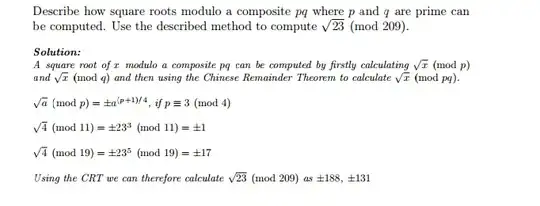$\sqrt 4$ seems to be a misprint. Note that the text continues with $\pm23^3$, which matches $\pm a^{(p+1)4}$ with $a=23$ and $p=11$. (Similarly for the last line).
How to find yolutions with CRT?
Note that $11$ is $\equiv 0\pmod{11}$ and $\equiv 11\pmod{19}$. Try to find a multiple of $11$ that looks simpler modulo $19$. For example $22$ is already "just" $3\pmod{19}$; take this times six to arrive at $12\cdot 11\equiv -1\pmod{19}$; now take the negative to find $(19-12)\cdot 11=77\equiv 1\pmod{19}$. So $77$ is $\equiv 0\pmod{11}$ and $\equiv 1\pmod {19}$.
Similarly, start with $19$, which is $-3\pmod {11}$; times four gives $-12\equiv -1$; thus $(11-4)\cdot 19\equiv1\pmod {11}$. Hence $133$ is $\equiv 1\pmod{11}$ and $\equiv 0\pmod {19}$.
This allows us to find a number that is $\equiv -1\pmod {11}$ and $\equiv +17\pmod{19}$, for example: Just take $(-1)\cdot 133+17\cdot 77$. All four combinations of $\pm1$ with $\pm17$ give different numbers (which you should of course reduce downto the range $0,\ldots,208$).
The trial-and-error approach used above to find base solutions that are $\equiv1$ modulo one prime and $\equiv0$ modulo the other(s) can be made systematic with the extended Euklidean algorithm.
